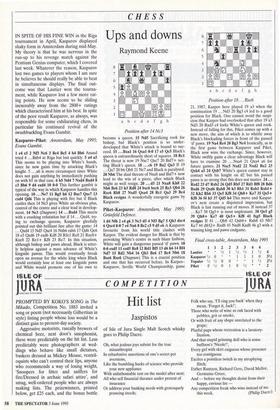CHESS
Ups and downs
Raymond Keene
IN SPITE OF HIS FINE WIN in the Riga tournament in April, Kasparov displayed shaky form in Amsterdam during mid-May. My theory is that he was nervous in the run-up to his revenge match against the Pentium Genius computer, which I covered last week. Whatever the reason, Kasparov lost two games to players whom I am sure he believes he should really be able to beat in simultaneous displays. The final out- come was that Lautier won the tourna- ment, while Kasparov lost a few more rat- ing points. He now seems to be sliding inexorably away from the 2800+ ratings which characterised him at his best. In spite of the poor result Kasparov, as always, was responsible for some exhilarating chess, in particular his continued revival of the swashbuckling Evans Gambit.
Kasparov-Piket: Amsterdam, May 1995; Evans Gambit.
1 e4 eS 2 NO Nc6 3 Bc4 Bc5 4 b4 Bb6 Anand tried 4 ... Bxb4 at Riga but lost quickly. 5 a4 a5 This seems to be playing into White's hands, since he now pains time by attacking Black's knight. 5 a6 is more circumspect since White does not gain anything by immediately pushing on with b5 in that case. 6 b5 Nd4 7 Nxd4 Bxd4 8 c3 Bb6 9 d4 exd4 10 0-0 This further gambit is typical of the way in which Kasparov handles this opening. 10 ...Ne7 11 Bg5 h6 12 Bxe7 Qxe7 13 exd4 Qd6 This is playing with fire but if Black castles then 14 Nc3 gives White an obvious plus, control of the centre and a clear lead in develop- ment. 14 Nc3 (Diagram) 14 ... Bxd4 This meets with a crushing refutation but if 14 ... Qxd4, try- ing to exchange queens, Kasparov gleefully pointed out this brilliant line after the game: 14
Qxd4 15 Nd5 Qxc4 16 Nxb6 cxb6 17 Qd6 Qe6 18 e5 Qxd6 19 exd6 Kd8 20 Rfel Re8 21 Rxe8+ Kxe8 22 Rel + Kf8 23 Re7. In this situation, although bishop and pawn ahead, Black is utter- ly helpless against a mass advance of White's kingside pawns. This would eventually break .open an avenue for the white king when Black would certainly lose at least one kingside pawn and White would promote one of his own to
Position after 14 Nc3 become a queen. 15 Nd5 Sacrificing rook for bishop, but Black's position is so under- developed that White's attack is bound to suc- ceed. 15 ...Bxal 16 Qxal 0-0 17 e5 Qc5 Black's queen is extraordinarily short of squares. 18 Rcl The threat is now 19 Nxc7 Qxc7 20 Bxf7+ net- ting Black's queen. 18 ...c6 19 Bat Qa3 If 19 Qa7 20 b6 Qb8 21 Nc7 and Black is paralysed. 20 Nb6 The dual threats of Nxa8 and Bxf7+ now lead to the win of a piece, after which Black might as well resign. 20 ...d5 21 Nxa8 Kh8 22 Nb6 Be6 23 h3 Rd8 24 bxc6 bxc6 25 Rc3 Qb4 26 Rxc6 Rb8 27 Nxd5 Qxa4 28 Rcl Qa3 29 Bc4 Black resigns A wonderfully energetic game by Kasparov.
Piket-Kasparov: Amsterdam, May 1995; Griinfeld Defence.
1 d4 Nf6 2 c4 g6 3 Nc3 d5 4 Nf3 Bg7 5 Qb3 dxc4 6 Qxc4 0-0 7 e4 Na6 8 Be2 c5 9 d5 e6 A Kasparov favourite from his world title clashes with Karpov. The evident danger for Black is that by provoking White's centre in such blunt fashion, White will gain a dangerous passed 'd' pawn. 10 0-0 exd5 11 exd5 Re8 12 Rdl Bf5 13 d6 h6 14 Bf4 Nd7 15 Rd2 NW 16 Qb3 Be6 17 Bc4 Nb6 18 Bxe6 Rxe6 (Diagram) This is a crucial position and one that has occurred before. In Karpov- Kasparov, Seville World Championship, game Position after 18 ... Rxe6 21, 1987, Karpov here played 19 a3 when the continuation 19 ...Nd3 20 Bg3 c4 led to a good position for Black. One cannot avoid the suspi- cion that Karpov had overlooked that after 19 a3 Nd3 20 Rxd3 c4 forks White's queen and rook. Instead of falling for this, Piket comes up with a new move, the aim of which is to whittle away Black's blockading forces in front of the passed 'd' pawn. 19 Na4 Re4 20 Bg3 Nc4 Ironically, as in the first game between Kasparov and Piket, Black now wins the exchange. Since, however, White swiftly gains a clear advantage Black will have to examine 20 ...Nxa4 21 Qxa4 a6 for future games. 21 NxcS Nxd2 22 Nxd2 Reg 23 Qxb4 a5 24 Qxb7 White's queen cannot stay in contact with his knight on d2 but his passed pawn is so strong that this does not matter. 24 ... Rxd2 25 d7 Rxb2 26 Qd5 Rb5 27 Rdl Bf8 28 Bd6 Bxd6 29 Qxd6 Rabb 30 h3 Rbl 31 Rxbl Rxbl + 32 KU Rb6 33 Qe5 Kf8 34 Qh8+ Ke7 35 Qe5+ Kf8 36 f4 h5 37 Qd5 h4 This move and Kaspar- ov's next create a disjointed impression, but Black is fast running out of moves. If instead 37 Ke7 38 0g5+ is most unpleasant. 38 Qe5 g5 39 Qh8+ Ke7 40 Qe5+ Kf8 41 fkg5 Black resigns If 41 ... Qb8 42 Qxb8+ Rxb8 43 Nb7 Ke7 44 d8/Q + Rxd8 45 Nxd8 KxdS 46 g3 with a winning king and pawn endgame.
Final cross-table, Amsterdam, May 1995
1 1 2 2 3 3 4 4
Lautier • •
1/2
1
1/2 1/2
1 la
4 Kasparov 1/2
0
*
• 1 1 1 0
3112 Topalov 1/2 1/2
0
0 *
1
la
21/2
Piket 0 '/2 0 1 0
12
* *
2


































































 Previous page
Previous page